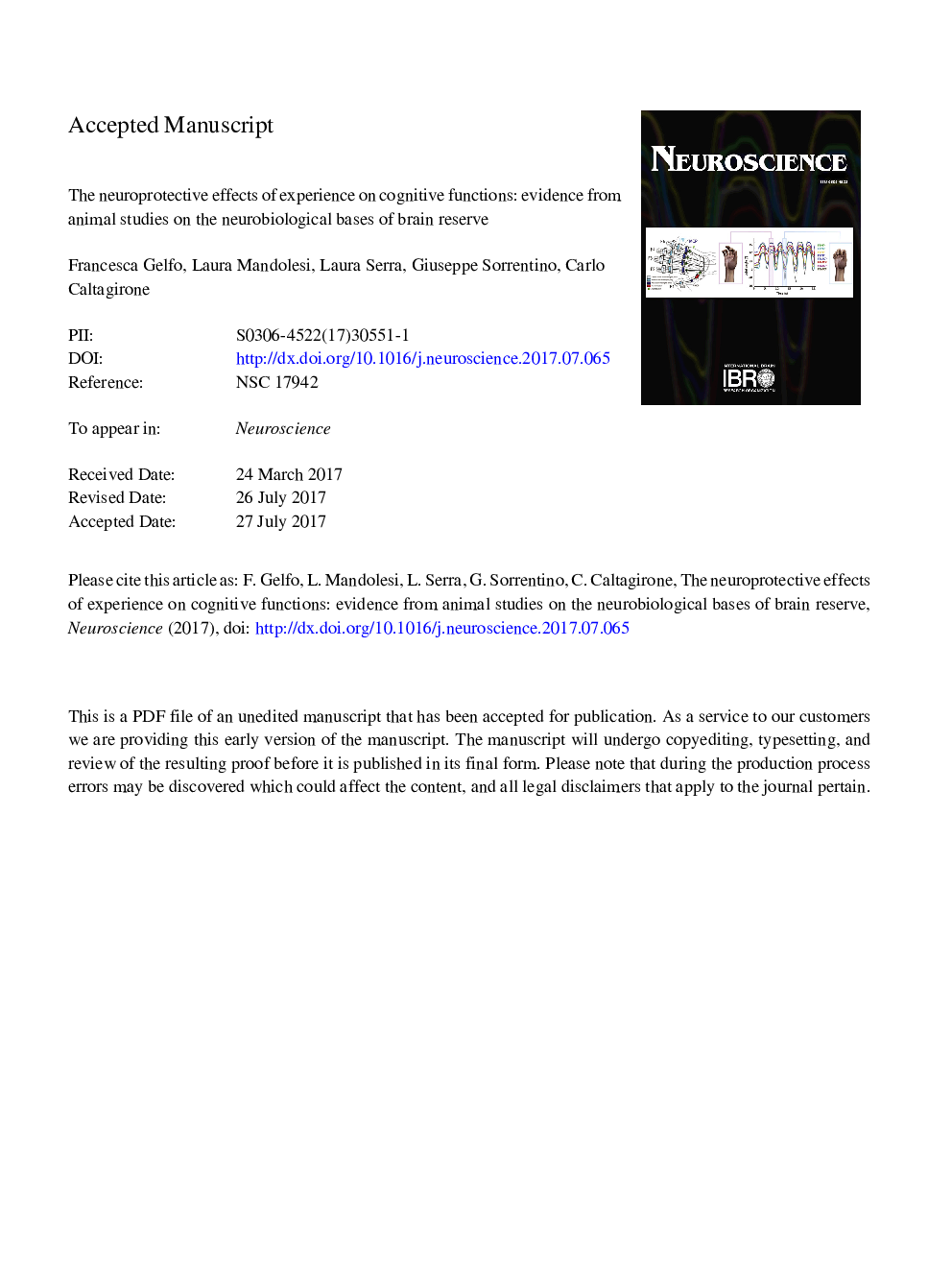| کد مقاله | کد نشریه | سال انتشار | مقاله انگلیسی | نسخه تمام متن |
|---|---|---|---|---|
| 8841126 | 1614706 | 2018 | 40 صفحه PDF | دانلود رایگان |
عنوان انگلیسی مقاله ISI
The Neuroprotective Effects of Experience on Cognitive Functions: Evidence from Animal Studies on the Neurobiological Bases of Brain Reserve
ترجمه فارسی عنوان
اثرات عصبی حفاظت در مورد توابع شناختی: شواهد از مطالعات حیوانی بر پایه های نوروبیولوژیک ذخایر مغز
دانلود مقاله + سفارش ترجمه
دانلود مقاله ISI انگلیسی
رایگان برای ایرانیان
کلمات کلیدی
ذخیره مغز، غنی سازی محیطی، مدل های حیوانی، نوروپلاستی، کاهش سن شناختی، بیماری های مرتبط با سن
ترجمه چکیده
انعطاف پذیری مغز توانایی سیستم عصبی در پاسخ دادن به تجربه در ساختار و عملکرد است. با شکل دادن به ساختار و عملکرد مغز، تجربه منجر به ایجاد یک ذخایر محافظتی می شود که منجر به تفاوت های افراد در حساسیت به تغییرات و پاتولوژی مغز مرتبط با سن می شود. این بررسی با هدف بررسی پایگاه های بیولوژیکی وابسته به تجربه مغز ذخیره شده است. با توصیف نتایج مطالعات حیوانی که بر اثرات نورولوژیک و مولکولی غنی سازی محیطی متمرکز شده است. به طور خاص، اثرات در سطح سلولی از لحاظ تغییرات در نوروژنز، گلیوژنز، آنژیوژنز و سیناپتوزیسم در نظر گرفته می شود. علاوه بر این، اثرات در سطح مولکولی، نشان دهنده تغییرات ژن و پروتئین در انتقال دهنده های عصبی و نوروتروفین است. شواهد تجربی برای پیامدهای اساسی بیولوژیکی غنی سازی محیط برای حیوانات سالم توصیف شده است. در نتیجه، با بحث درباره یافته های مدل های حیوانی که تقلید بیماری های مرتبط با سن را دارند، دخالت چنین تغییرات پلاستیکی در حمایت از ارگانیسم به عنوان مقابله با کاهش طبیعی شناختی و آسیب شناختی مرتبط با سن، در نظر گرفته می شود. در کل، مطالعات اثرات ساختاری و مولکولی غنی سازی محیطی به شدت از فعالیت عصبی حفاظت از یک شیوه خاص تحریک کننده بر عملکردهای شناختی حمایت می کند. سطح فعلی درک ما از این اثرات و مکانیزم ها این است که مطالعات اضافی و جدید، بررسی های سیستماتیک و متاآنالیز برای بررسی اثرات خاص اجزای مختلف غنی سازی محیط در هر دو مدل سالم و پاتولوژیک ضروری هستند. فقط در این راه توصیه های جامع برای عادات زندگی مناسب می تواند توسعه یابد.
موضوعات مرتبط
علوم زیستی و بیوفناوری
علم عصب شناسی
علوم اعصاب (عمومی)
چکیده انگلیسی
Brain plasticity is the ability of the nervous system to change structurally and functionally in response to experience. By shaping brain structure and function, experience leads to the creation of a protective reserve that accounts for differences among individuals in susceptibility to age-related brain modifications and pathology. This review is aimed to address the biological bases of the experience-dependent “brain reserve” by describing the results of animal studies that focused on the neuroanatomical and molecular effects of environmental enrichment. More specifically, the effects at the cellular level are considered in terms of changes in neurogenesis, gliogenesis, angiogenesis, and synaptogenesis. Moreover, the effects at the molecular level are described, highlighting gene- and protein-level changes in neurotransmitter and neurotrophin expression. The experimental evidence for the basic biological consequences of environmental enrichment is described for healthy animals. Subsequently, by discussing the findings for animal models that mimic age-related diseases, the involvement of such plastic changes in supporting an organism as it copes with normal and pathological age-related cognitive decline is considered. On the whole, studies of the structural and molecular effects of environmental enrichment strongly support the neuroprotective action of a particularly stimulating lifestyle on cognitive functions. Our current level of understanding of these effects and mechanisms is such that additional and novel studies, systematic reviews, and meta-analyses are necessary to investigate the specific effects of the different components of environmental enrichment in both healthy and pathological models. Only in this way can comprehensive recommendations for proper life habits be developed.
ناشر
Database: Elsevier - ScienceDirect (ساینس دایرکت)
Journal: Neuroscience - Volume 370, 1 February 2018, Pages 218-235
Journal: Neuroscience - Volume 370, 1 February 2018, Pages 218-235
نویسندگان
Francesca Gelfo, Laura Mandolesi, Laura Serra, Giuseppe Sorrentino, Carlo Caltagirone,
